Ireland at the Turn of the Century
Published in 20th-century / Contemporary History, Features, Issue 4 (Winter 1999), Volume 7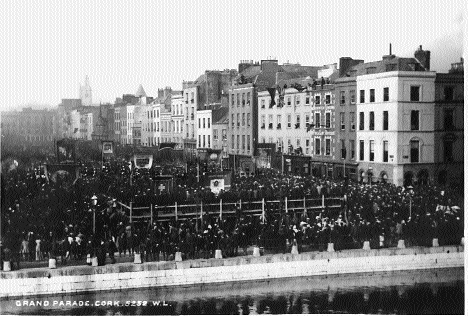
A temperance rally at Grand Parade, Cork. Temperance candidates scored some successes in the local elections of 1899. The Pioneer Total Abstinence Association was founded in the same year. (National Library of Ireland)
The approach of the millennium risks overshadowing the fact that 1999 is a fin de siècle year. Despite the predictable onset of millennium fever, the passage of a century is a more meaningful historical event. It is difficult to make any sense of a thousand years of history. Centuries contain more manageable slices of time. Many who read this will remember parents and grandparents who were born in ‘the last century’. Our own century will soon become ‘the last century’ and this will change the way we view our past. As an eventful hundred years of Irish history draws to a close, balance sheets are bound to be drawn up measuring the impact of political independence, social change and economic advancement.
Ireland ‘in a plastic state’
W.B. Yeats described the strong sense he had at the turn of the last century ‘that Ireland was to be like soft wax for years to come’. At the time, he maintained that ‘a new period of political activity’ was on the way, with urban discontent rather than land grievances at its heart. George Wyndham, appointed Irish chief secretary after the general election of 1900, voiced a similar assessment. Ireland was, he felt, ‘in a plastic state’, and could be moulded ‘almost at will’. Romantic nationalists and liberal unionists were at one in believing that the country’s destiny was there for the shaping. The Ireland of Parnell and his lieutenants, whose politics were dominated by parliamentary considerations at Westminster, was on the wane. A new brand of nationalism, pioneered by the Gaelic League, with its enhanced sense of the nation’s distinctive heritage, was beginning to challenge the old political order as the twentieth century dawned.
‘In a peaceful condition’
And yet, as Ireland’s calamitous nineteenth century meandered to its end, the country seemed to have been pacified. Confidential police reports to the chief secretary’s office in Dublin Castle told of a society ‘in a peaceful condition’. Admittedly, in December 1899 there were still 174 incidents classified by the police as agrarian ‘outrages’ while thirty-four evictions were carried out. Scores of people still required police protection on account of tensions surrounding land ownership issues, but all of this was small beer compared with the turbulence of the Land War.
The centenary of the 1798 Rebellion passed without exciting new nationalist fervour. William O’Brien, one of Charles Stewart Parnell’s lieutenants who had broken with him and drifted out of politics, attempted a comeback in 1898, establishing a new organisation, the United Irish League, which, he hoped, would take up the cudgels for further land reform. O’Brien’s League made a faltering start, failing initially to make much of an impact outside of County Mayo where it originated. Nearly a decade after Parnell’s fall, parliamentary nationalism was still deeply divided into pro- and anti-Parnell factions. All efforts at reuniting the Home Rule party had foundered in a climate of mutual suspicion and rivalry between the leading Irish parliamentarians, John Redmond, John Dillon and Tim Healy.
The Boer War
Into this Irish impasse, entered an African factor when, in October 1899, the Boer War broke out. Logically, this imperial spat should have made little impact in faraway Ireland, but somehow it did.
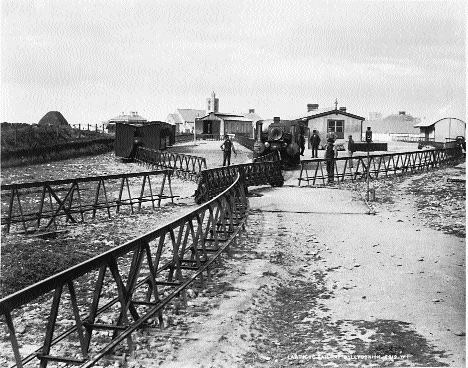
The late-nineteenth century was a boom time for light railways. North Kerry’s Lartigue railway, which linked Ballybunion and Listowel between 1888 and 1924, was surely the most unusual. (National Library of Ireland)
Towards the end of 1899, another police report noted with some astonishment how pro-Boer sentiment was not confined to what were termed ‘the disaffected classes’, but acknowledged that nationalists were ‘fairly unanimous’ on the subject of the war. News of Boer successes in the closing weeks of 1899 brought celebratory crowds on to the streets of Dublin and there were clashes with ebulliently loyal students at Trinity College. When Britain’s Colonial Secretary, Joseph Chamberlain, disliked in Ireland as the man who had split the Liberal Party in 1886 because of his opposition to Gladstone’s plans for Irish Home Rule, came to receive an honorary degree from Trinity, Arthur Griffith, James Connolly and Maud Gonne were involved in demonstrations against the visit of the architect of the Boer War. In Ulysses, James Joyce has Leopold Bloom recall the occasion when mounted police charged the crowd down Dame Street, even if Bloom did not think much of the demonstrators’ motives:
We’ll hang Joe Chamberlain from a sourapple tree. Silly billies. Mob of young cubs yelling their guts out… Few years’ time half of them magistrates and civil servants. War comes on: into the army helter skelter: same fellows used to whether on the scaffold high.
The war was particularly divisive in Ulster where nationalists celebrated Boer triumphs while unionists did likewise for British victories. Disgusted by the war, Michael Davitt resigned his Westminster seat and travelled to the Transvaal to observe the situation there at first hand. The book of his experiences in South Africa, The Boer Fight for Freedom, eulogised the Boers and indicted what he saw as the arrogance and materialism of the British Empire.
Irish nationalists saw lessons for Ireland in the manner in which the Boers had taken on the might of the Empire. While MPs like John Redmond might look forward to a time when a Home Rule Ireland would be happy to partner Britain in running the Empire, the Boer War prompted many nationalists to turn their backs on imperialism. It scarcely mattered that many thousands of Irishmen fought and died in the battles of the South African War. Their monument still stands at the entrance to Dublin’s St Stephen’s Green. Like many others, I walked under its archway thousands of times before realising its significance. No doubt, most of the Irish who fought in the British Army under the command of Lords Roberts and Kitchener, with their respective Waterford and Kerry connections, were neither imperialists nor nationalists, but just soldiers. A letter from one Irish soldier captures the mixed emotions deployed in warfare:
It was an awful sight to see us walking over our dead and wounded comrades, but still we could not help them, not knowing the moment we would be shot ourselves…we went in the rale ould [sic] Irish style and the Boers who pluckily stuck to their position had to suffer with cold steel…the Boers are great men and when we go home if we come through it all right I will tell you all about it. I wish this will arrive safe and find you in the best of health and spirits, and that old Ireland will yet be free.
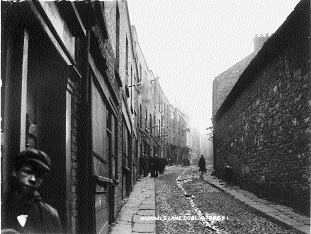
Tenements in Michael’s Lane. Turn-of-the-century Dublin was notorious for its overcrowded and unsanitary tenements, which bred infectious disease.
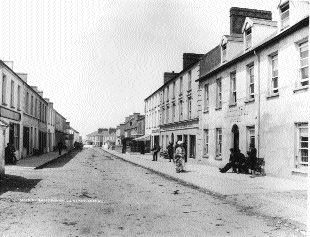
The fashionable, but uncrowded, Victorian resort of Ballybunion, County Kerry. Tourism was a growth industry at the turn of the century. (National Library of Ireland)
Within months of the outbreak of war, nationalist Ireland had been reinvigorated. The Irish Parliamentary Party was finally reunited in January 1900 under John Redmond, nationalist Ireland’s last leader at Westminster. The United Irish League spread rapidly throughout the country, exciting considerable public enthusiasm as its meetings were often held in defiance of Dublin Castle bans. At a National Convention held at Dublin’s Rotunda in June 1900, the League became the Irish Parliamentary Party’s grassroots organisation.
Queen Victoria’s visit
The eighty-year-old Queen Victoria paid a three-week visit to Ireland in April 1900 as part of an effort to boost army recruitment. No great admirer of Ireland, the queen had not crossed the Irish Sea for thirty-seven years. Maud Gonne composed a fiery article branding the royal visitor ‘the Famine Queen’. The offending edition of Arthur Griffith’s magazine, The United Irishman, was seized by the police. Although nationalists were at best lukewarm about the visit, and many wore miniature Boer flags, the queen appears to have been fairly well-received. The general view seems to have been that no disrespect should be shown towards the person of the aged monarch. Unionist-owned businesses ensured that the streets were gaily festooned along the royal route from Kingstown to the Phoenix Park where she stayed at the vice-regal lodge.
Advanced nationalism
The outbreak of the Boer War ensured that the turn of the century would be a productive time for advanced nationalism. Police reports recorded efforts by secret societies to capitalise on pro-Boer sentiment by recruiting new members. Buoyed by her efforts to discourage Irish enlistment in the British army, Maud Gonne helped found Ighnidhne na hÉireann (Daughters of Erin) in 1900, while Arthur Griffith brought together various political and cultural organisations that had sprung up around the country during the 1890s under the umbrella of Cumann na nGaedhael. Five years later, this organisation turned into Sinn Féin.
While circumstances at the turn of the century may have conspired to revive nationalist fortunes, the chief secretary, Gerald Balfour, who headed up the Irish administration, remained the country’s most powerful political figure. Balfour, a nephew of the Prime Minister, Lord Salisbury, was responsible for implementing the Conservative government’s policy of introducing reforms in the hope of sapping nationalist enthusiasm for Home Rule. Gerald Balfour, whose brother, Arthur had been chief secretary during the Land War, coined the phrase, ‘killing Home Rule with kindness’. During his term of office, he presided over a land act; the expansion of the country’s light railways; fundamental reform of local government in 1898 which effectively handed control of local authorities to nationalists; and the establishment of a new Department of Agriculture and Technical Instruction under the leadership of Sir Horace Plunkett. An advocate of agricultural co-operation, Plunkett believed that Ireland’s woes were of an economic character and required an economic remedy.
Wyndham land act
After the general election of 1900, Balfour was replaced as chief secretary by George Wyndham, the great grandson of the 1798 leader, Lord Edward Fitzgerald. Wyndham approached his task with relish and set out to pull off a ‘grand slam’ of land legislation, a university reform that would satisfy Catholic demands, and political devolution. Only one of these goals was accomplished. Clamour for land reform excited unionists and nationalists alike. The Liberal Unionist MP, T.W. Russell, campaigned for compulsory land purchase and won considerable support amongst Ulster’s tenant farmers. The Wyndham land act of 1903 was the product of a unique consensus between landlord and tenant interests which appeared to point the way towards a new style of politics. The erstwhile agrarian agitator, William O’Brien, was converted to conciliation.
The promising spirit behind the Wyndham land act soon evaporated. O’Brien left the Irish Party in dispute, while Wyndham’s career perished on the rocks of an ill-prepared and mishandled devolution scheme which led to his resignation as chief secretary in 1904.
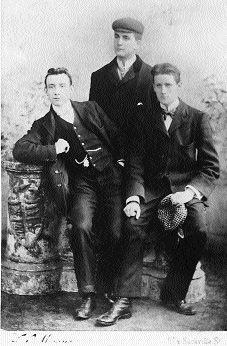
A young James Joyce (cap in hand) with two of his university class-mates, George Clancy and J.F. Byrne. Clancy (Davin in Joyce’s A Portrait) was Mayor of Limerick when he was killed by Black and Tans during the War of Independence. (Morris Library, Southern Illinois University, Carbondale)
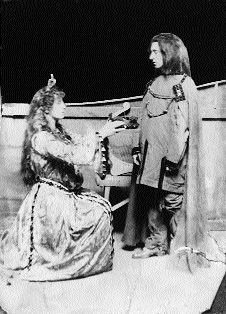
An early twentieth century production of W.B. Yeats’s The Shadowy Waters. (National Library of Ireland)
This ‘devolution crisis’ also resulted in the formation of the Ulster Unionist Council which, almost a century later, remains the governing political body within unionism.
Economic mess
The Ireland of a century ago was in an economic mess. Its population had plummeted by more than three and a half million since the Famine and was still in decline. There were some 250,000 fewer people on the island in 1901 than there had been in 1891. Late-nineteenth century Ireland was a country of tiny farmsteads and nasty urban tenements. It was an era when some Irish people still lived in mud cabins. Partial failure of the potato crop, which happened a number of times during the 1890s, was still capable of generating what late-Victorian administrators coyly called ‘distress’. This was a time before the introduction of old age pensions and social welfare arrangements when the workhouse, however harsh its conditions might be, was often the only place of refuge for the aged, the infirm and the indigent. To many, emigration offered the only prospect of a better life. More than 32,000 people left in 1899 alone, giving Ireland a higher emigration rate than any other part of Europe. There were thousands of others who migrated for part of the year in search of seasonal labour whose proceeds could help sustain their families at home.
Infant death was still commonplace. Almost one in every four children born in Dublin died before their first birthday. In Belfast, during one four-week period in 1900, there were as many deaths of children less than one year old as there were of adults over sixty years of age. At a time when medicine was far less advanced than it is today, one-third of all deaths resulted from chest infections. Although average life expectancy had climbed significantly from its pre-Famine level of under forty years, at the turn of the century a normal life span was still some twenty years shorter than it is today.
Literature and theatre thriving
In contrast to the state of its economy, the country’s literary community was thriving. In February 1900, supporters of the Irish Literary Theatre sat down to a gala luncheon at the Shelbourne Hotel to celebrate the theatre’s second season. The assembled diners heard George Moore declare his commitment to the revival of the Irish language which he deemed necessary if Ireland was ‘to preserve her individuality among nations’. Moore was a curious cultural convert. He had made his reputation as an English novelist, his only previous Irish publication being a pamphlet critical of Parnell and his movement. He returned to live in Dublin in 1901 and later produced memoirs, Hail and Farewell, which chronicled the century’s first decade when Ireland was a hive of literary activity.
The Irish Literary Theatre ran into controversy in 1899 when a group of Dublin students turned up at the theatre to protest the suggestion in Yeats’s play, The Countess Cathleen, that an Irish woman would be willing to sacrifice her soul to save the peasantry from the ravages of famine. James Joyce took pride in his refusal to join the protest. He made his published début in 1900 with an article in a London journal about the work of the Norwegian playwright, Henrik Ibsen, and took his father to London with the proceeds of the twelve guineas he earned. It was not long before Joyce’s enthusiasm for European literature put him at loggerheads with the Irish literary revival which he subjected to a withering attack in an essay called ‘The Day of the Rabblement’ published as a pamphlet in 1901.
Joyce’s critique notwithstanding, there has never been a time when Ireland was so well endowed with creative writers as it was a hundred years ago. Yeats was approaching the peak of his powers. Publication in 1899 of The Wind Among the Reeds marked the culmination of his early work which he described as
‘Building a sorrowful loveliness Out of the battles of old times.’
He was in the process of developing the harder-edged style of his greatest poems, lashing out at the
‘…noisy set
Of bankers, schoolmasters and clergymen
The martyrs call the world.’
Yeats was busy encouraging John Millington Synge to visit the Aran Islands where he gathered inspiration for his greatest works. Ulysses, the most celebrated modern novel in the English language, is based on experiences Joyce accumulated in the early years of the century before he left Ireland for good in 1904. On November 1900, Oscar Wilde, perhaps the pivotal fin de siècle writer, died in the Hotel d’Alsace in Paris, having fled England in poverty and disgrace following his release from prison. It took almost a hundred years for Wilde to be fully rehabilitated with new monuments to his memory being erected in Dublin and London.
The Gaelic League
The literary revival was not the only revival under way in Ireland at the turn of the century. The effort to restore the Irish language was already in full swing as the nineteenth century elapsed. Founded in 1893, the Gaelic League gathered adherents rapidly in the years that followed. In 1899, Douglas Hyde, the driving force behind the League, published A Literary History of Ireland, one of the key building blocks of advanced nationalism’s understanding of Irish history. By 1900, the league had 2,000 people attending its language classes in London. Back in Ireland, a very young Patrick Pearse was already a member of the league’s executive and participated in a delegation that lobbied Dublin Corporation in support of the league’s demand for greater status for Irish within the education system.
The Gaelic League was responsible for publishing An Claidheamh Soluis, one of the many fine Irish publications that ensured there was no shortage of intelligent debate at the turn of the century. Perhaps the most influential of these was The Leader, founded by the journalist D.P. Moran in September 1900. Moran was a strong believer in the revival of the Irish language and in fostering Irish industry. His vigorous pen took aim at everything considered insufficiently Irish for his liking. Although he contributed an essay to Lady Gregory’s literary revival collection, Ideals in Ireland, Moran soon took exception to the claims of Anglo-Irish literature and targeted Yeats and George Russell (Æ), questioning the genuineness of their Irish identity given their insistence that Irish literature could be written in English. Moran developed a ‘philosophy of Irish-Ireland’. As he saw it, ‘a battle of two civilisations’ was being waged between native traditions and English influences. Moran propagated an Irish identity delineated by what James Joyce called the ‘nets’ of language, religion and nationalism. These so dismayed the young Joyce that he chose to ‘fly’ them and opted to live outside of Ireland for the remainder of his life.
Moran’s Irish-Ireland ideas, forged in the intellectual ferment of the turn of the century, were to exercise considerable influence in the decades that followed as the fledgling Irish state sought to make a reality of independence. Moran’s ideas encouraged an inward-looking ethos, suspicious of the outside world, but convinced of Ireland’s unique virtues as a Gaelic, Catholic nation. They were in tune with the conservative temper of the society that emerged from the revolutionary decade between 1912 and 1922. In the process, however, much of the expansive and inclusive spirit exhibited at the turn of the century was lost. Ireland’s contemporary history has been shaped by the need to come to terms with the rich, but divisive, legacy of the age of national revival that coincided with the birth of the twentieth century. As another century looms, the ‘nets’ that bothered Joyce have been cast off and the conservative spirit of Irish-Ireland is no more. But, as we approach a new century, there would not appear to be any contemporary equivalent of the national aspirations that pervaded Ireland a century ago and spawned such a creative generation. Is there a need for a new set of national ideals to steer our course beyond the millennium?
Daniel Mulhall is the Irish Consul General in Edinburgh.
Further reading:
D. Mulhall, A New Day Dawning: a portrait of Ireland in 1900 (Cork 1999).
A. Briggs & D. Snowman (eds.), Fins de Siècle: how centuries end, 1400-2000 (Yale 1996).
P. Costello, The Heart Grown Brutal: the Irish revolution in literature from Parnell to the death of Yeats, 1891-1939 (Dublin 1977).
F.S.L. Lyons, Culture and Anarchy in Ireland 1890-1939 (Oxford 1979).
















